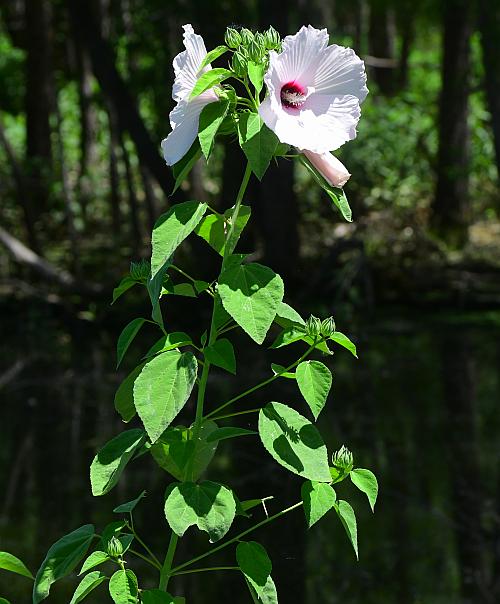Hibiscus lasiocarpos Cav.
Hairy Rose Mallow

Native
CC = 5
CW = -5
MOC = 43
© SRTurner
Hibiscus lasiocarpos Cav.Hairy Rose Mallow | |
 |
Native CC = 5 CW = -5 MOC = 43 |
© SRTurner |
|
Family - Malvaceae Habit - Perennial forb, sometimes slightly woody at the base. Stems - Ascending to erect, to 2.0 m, branching, densely pubescent with mostly stellate hairs, less commonly glabrous or nearly so.
Leaves - Alternate, simple, petiolate. Petiole to 8 cm long, glabrous and glaucous to sparsely pubescent, reddish. Blades 4-20 cm long, lanceolate to broadly ovate in outline, unlobed or less commonly with small lobes at the base, the margins finely to coarsely scalloped or bluntly toothed, the upper surface moderately to densely pubescent with stellate hairs, sometimes becoming glabrous or nearly so with age, the undersurface densely pubescent with stellate hairs. Stipules shed during leaf development.
Inflorescence - Solitary, terminal or axillary pedunculate flowers. Peduncle to 4 cm long, reddish, glabrous and glaucous to pubescent. Flowers subtended by ring of 8-12 conspicuous linear bracts, these 1.8-3.5 cm long, densely pubescent with stellate hairs and usually also with simple or fasciculate hairs along the margin.
Flowers - Calyces 15-40 mm long at flowering, not becoming enlarged or inflated at fruiting, finely pubescent with stellate hairs, especially along the veins. Corolla large, to 15 cm broad, white or less commonly pink, often with a dark reddish purple throat, the petals 6.5-12.0 cm long, adnate to stamen column at base. Stamens numerous. Filaments to 3 mm long. Anthers 2 mm long. Carpels 5. Style 5-parted near apex. Stigmas 5, capitate.
Fruits - Capsules 1.5-3.2 cm long, ovoid to ovoid-cylindric, densely pubescent with stellate hairs and also with longer simple or fasciculate hairs, especially along the margins of the valves. Seeds 18-35 per locule, 2.5-3.0 mm long, obovoid to nearly globose, the surface minutely pebbled or roughened and with a faint pattern of fine parallel ridges, orangish brown to black, glabrous.
Flowering - July - October. Habitat - Bottomland forest openings, swamps, riverbanks, pond margins, sloughs, ditches, wet roadsides, sometimes growing in shallow water. Origin - Native to the U.S. Lookalikes - H. laevis, H. moscheutos. Other info. - This showy species with strikingly large flowers is common in most Missouri counties south of the Missouri River. It is especially prevalent in Bootheel counties, where it grows profusely in roadside wet ditches along miles of roadside. Beyond Missouri its range extends slightly eastward throughout southern Illinois, and southward through several states to the Gulf Coast. The plant is easily recognized by its wet habitat and very large flowers. It differs from its close relative H. laevis in having leaves which are densely hairy and usually unlobed at the base. Any leaf lobing present is much smaller than that seen on H. laevis. The plant is quite variable in its pubescence. Some plants are almost completely glabrous and others just a meter away are densely pubescent. The flowers are very showy and dominate the landscape when in full bloom. This is a great native plant to use in a wet garden location. The seeds are easy to collect, as the capsule stays within the persistent calyx until it dries and falls. Corollas are typically white with wine-colored base, but pink flowered plants are found also. Here is a pink plant:
Some authors consider H. lasiocarpos a variety or subspecies of the eastern species H. moscheutos, e.g. Hibiscus moscheutos ssp. lasiocarpos (Cav.) O.J. Blanch. According to this treatment, the other form, ssp. moscheutos, is found in states adjacent to Missouri on both the eastern and western borders, and could be expected to be found in Missouri. It differs in having glabrous fruits, bractlets without longer spreading hairs along the margins, and more glabrous upper leaf surfaces. The species epithet lasiocarpos means "hairy fruit." This description applies only to the fruit capsule, as the seeds are glabrous. Photographs taken off Hwy 60 near Poplar Bluff, MO., 8-8-04, and off Hwy 70 east of St. Louis, MO., 8-7-05 (DETenaglia); also at Shaw Nature Reserve, Franklin County, MO, 8-9-2008, 2-20-2020, and 8-28-2021, Marais Temps Clair Conservation Area, St. Charles County, MO, 7-19-2010, 8-2-2018, and 7-28-2020, Otter Slough Conservation Area, Stoddard County, MO, 8-19-2013, and Holly Ridge Conservation Area, Stoddard County, MO, 8-15-2021 (SRTurner). |